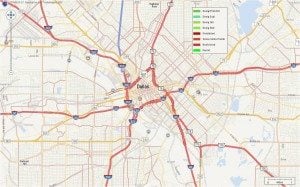This story made me think about a thing I basically never think about, and now I wish I didn’t have to think about it.
Toxic inhalants, flammable gases and explosive chemicals are just some of what rolls along Dallas-Fort Worth area highways every day. A simple road accident involving an 18-wheeler carrying hazardous materials could put dozens of people, if not whole neighborhoods, at risk.
Trucks carrying volatile chemicals rumble down highways that were designated as “hazmat routes” in 1985, when the population of DFW was half the size it is now. At the time, large portions passed through sparsely populated areas.
Almost 40 years later, empty space has been replaced by businesses, residential neighborhoods — even schools and churches.
The hazmat routes are designed to minimize the chances of a mass-casualty event. They rely on truckers using them. But not all the trucks stay on those routes.
No one really knows how much hazardous materials pass through North Texas. And emergency personnel say they have virtually no way of knowing what’s being carried until an accident happens.
Trucks carrying hazardous materials are supposed to display placards that gives first responders some idea of what’s on board. But if a placard isn’t accurate — or has been obscured by fire or smoke – the threat may not be apparent.
And the threat is real. Trucks carrying hazardous materials have been involved in deadly accidents across the nation.
- In 2019 a semi-truck carrying empty propane tanks crashed into multiple other cars on I-35 near Denton. The truck and vapors seeping out of the propane tanks caught on fire, as did other vehicles. Three people were killed in the crash and three others were injured, according to incident and media reports.
- In 2020, a tanker truck carrying 8,500 gallons of fuel rear-ended a Volkswagen Passat that had stopped on a highway interchange in suburban Atlanta. The impact caused the tanker to rollover into four lanes of traffic and both vehicles caught fire. Both individuals died because of the crash, according to incident and media reports.
- And less than six months later on Valentine’s Day 2023, a tractor-trailer carrying over 3,000 gallons of nitric acid crashed along I-10 near Tucson. Reddish-orange fumes could be seen rising from the wreckage as the area was evacuated. The driver of the truck was killed in the collision, according to Arizona Department of Public Safety. Nitric acid is toxic if inhaled.
First responders and emergency planners say that errors in labeling hazmat materials – and truckers who fail to follow hazmat rules — can lead to a catastrophe. So can a shortage of people trained to handle hazmat emergencies.
“From radioactive waste to the most toxic chemicals that you can imagine all travel by truck transport through all our cities in the metroplex,” Grand Prairie Fire Capt. John Stevenson said. “It’s an obvious concern.”
As you might imagine, my first thought upon reading this was “Huh, I wonder what the hazmat routes are in the Houston area. A little googling took me to this TxDOT page, where you can see relevant maps for Dallas and Houston, plus a list of the non-radioactive hazardous material routes in the state. Basically, if I’m reading all this right, if you’re trucking on through with a load of hazmats, you take the Loop around whateve city you’re passing by, and not the main highway that would go through the middle of town. Simple, and sensible as it goes, but you can see what the article is pointing out, which is that those approved routes are a hell of a lot more full of people and buildings and cars than they were however many years ago when they were first designated.
And look, it’s not like the urban centers don’t get hazmats brought into them:
One complication is that trucks carrying hazardous materials sometimes must make deliveries to locations throughout a city. And by necessity they have to leave the designated routes.
“It’s nearly impossible to route all those carriers, because there are so many destinations that are now within our cities,” Kessler said.
Hazardous materials are integral to everyday life and industry. Small businesses from dry cleaners to filling stations require the delivery of hazardous materials.
Stevenson says it’s not always 18-wheeler trucks that carry the most dangerous cargo. Smaller vehicles making deliveries throughout the city are also a potential risk.
“They’re in sprinter vans and it’s in box trucks with miscellaneous packaging on it,” Stevenson said.
He says that these vehicles carry multiple substances or materials that alone are not toxic but when mixed creates something volatile which the vehicles aren’t placarded for.
Kessler says the bigger challenge with hazmat transport are “internal shipments” or deliveries within the city.
He said one thing that might mitigate that risk is speed — or the lack of it. Trucks delivering hazardous materials using city streets aren’t likely to be going as fast as on the highway, nor is other traffic.
Anyway. There’s more in there about law enforcement and emergency response – not every city has a firefighting unit that can handle hazmats – and more. It may make you never want to drive again, but go check it out anyway.


“a thing I basically never think about, and now I wish I didn’t have to think about it.”
Perfect statement about situations first responders are responsible for.
“a hell of a lot more full of people and buildings and cars than they were however many years ago when they were first designated.”
Another issue that is first responders’ concerns,
Something else you don’t want to think about: what is the status of your first responders? Especially if these situations give you such anxiety about basic daily functions as driving.